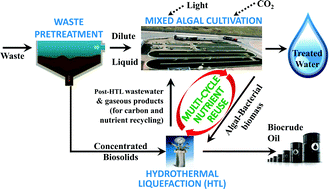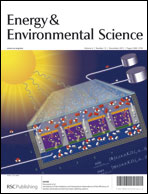A synergistic combination of algal wastewater treatment and hydrothermal biofuel production maximized by nutrient and carbon recycling†
Abstract
This study introduces and analyzes a novel system for algal biofuel production that synergistically integrates algal wastewater treatment with hydrothermal liquefaction (HTL) of wastewater biosolids and algae into bio-crude oil. This system maximizes the biofuel potential of wastewater inputs by internally capturing and recycling carbon and nutrients – a powerful concept referred to as multi-cycle nutrient reuse, which amplifies waste nutrients into multiple cycles of algal biomass and bioenergy production. We call this system “Environment-Enhancing Energy” (E2-Energy) because it can simultaneously improve conventional wastewater treatment by nutrient removal and production of a large amount of biofuel co-products. Moreover, E2-Energy resolves several key bottlenecks commonly associated with large-scale algal biofuel production including: contamination of target high-oil algal cultures, high nutrient costs/usage, unsustainable fresh water usage, and large energy inputs for dewatering/extraction. A series of algal cultivation and HTL experiments were conducted to confirm the primary steps and performance characteristics of the E2-Energy system. These experiments showed: (1) low-oil, mixed algal–bacterial biomass can be successfully cultured with the recycled HTL aqueous product; (2) both organics and nutrients are removed from wastewater during algal–bacterial biomass production (63–95% reduction); (3) this low-oil, algal–bacterial biomass can be converted into bio-crude oil via HTL with a high yield (∼50%) and a net positive energy balance; and (4) the HTL step re-releases nutrients to an aqueous phase product that can be recycled back to step (1). This repeating loop of steps 1–4 facilitates multi-cycle reuse of nutrients and thus provides biomass amplification. A mathematical model was also developed using STELLA® to simulate mass balances for long-term E2-Energy operations with internal recycling of nutrients and carbon. The model results showed that E2-Energy can amplify the biomass and biofuel production from wastewater by up to 10 times, which gives it the potential to replace all US petroleum imports using only current wastewater feedstocks and carbon dioxide from the atmosphere or point sources. Thus, E2-Energy represents a major paradigm shift—where wastewater treatment systems become optimized biofuel producers with enhanced effluent quality, which provides a viable and advantageous pathway to sustainable, carbon-neutral energy independence.


 Please wait while we load your content...
Please wait while we load your content...